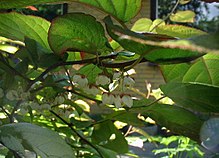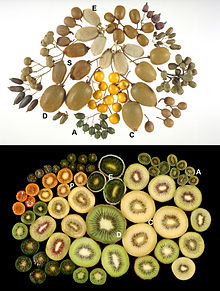Actinidia
| Actinidia Temporal range: | |
|---|---|

| |
| Actinidia kolomikta ('Arctic Beauty') | |
| Scientific classification | |
| Kingdom: | Plantae |
| Clade: | Tracheophytes |
| Clade: | Angiosperms |
| Clade: | Eudicots |
| Clade: | Asterids |
| Order: | Ericales |
| Family: | Actinidiaceae |
| Genus: | Actinidia Lindl. |
| Type species | |
| Actinidia callosa[1] Lindl. | |
Actinidia /ˌæktɪˈnɪdiə/[2] is a genus of woody and, with a few exceptions, dioecious plants native to temperate eastern Asia, occurring throughout most of China, Taiwan, Korea, and Japan, and extending north to southern areas of Russian Far East and south into Indochina. The genus includes shrubs growing to 6 metres (20 feet) tall, and vigorous, strong-growing vines, growing up to 30 m (100 ft) in tree canopies. They mostly tolerate temperatures down to around −15 °C (5 °F), and some are much hardier.
The leaves are alternate and simple, with a dentated margin and a long petiole. The flowers are solitary or in axillary cymes, usually white, with five small petals. Most of the species are dioecious with separate male and female plants, but some are monoecious. The fruit is a large berry containing numerous small seeds; in most species, the fruit is edible. In particular, this genus is known for the species Actinidia deliciosa, one of the most common cultivated kiwifruits, and for the hardy ornamental A. kolomikta.
Fossil record
Fossils of the extinct species A. faveolata are known from Europe and Western Siberia extending from the Upper Oligocene to the Early Pleistocene.[3]
Species
The 40–60 species of Actinidia include:
- Actinidia arguta – kokuwa, tara vine or hardy kiwi
- A. arguta var. cordifolia
- A. arguta var. giraldii
- A. arguta var. nervosa
- A. arguta var. purpurea
- Actinidia arisanensis
- Actinidia callosa
- A. callosa var. acuminata
- A. callosa var. discolor
- A. callosa var. ephippioides
- A. callosa var. formosana
- A. callosa var. henryi
- A. callosa var. strigillosa
- Actinidia carnosifolia
- A. carnosifolia var. glaucescens
- Actinidia chengkouensis
- Actinidia chinensis
- A. chinensis var. hispida
- A. chinensis var. jinggangshanensis
- A. chinensis var. setosa
- Actinidia chrysantha
- Actinidia cinerascens
- A. cinerascens var. longipetiolata
- A. cinerascens var. tenuifolia
- Actinidia cordifolia
- Actinidia coriacea – Chinese egg gooseberry
- Actinidia cylindrica
- A. cylindrica f. obtusifolia[citation needed]
- Actinidia deliciosa – kiwifruit, mi hou tao or Chinese gooseberry
- Actinidia eriantha
- Actinidia farinosa
- Actinidia fasciculoides
- A. fasciculoides var. cuneata
- A. fasciculoides var. orbiculata
- †Actinidia faveolata
- Actinidia fortunatii
- †Actinidia foveolata
- Actinidia fulvicoma
- A. fulvicoma var. lanata
- A. fulvicoma var. lanata f. arachnoidea[citation needed]
- A. fulvicoma var. lanata f. hirsuta[citation needed]
- A. fulvicoma var. pachyphylla
- A. fulvicoma var. lanata
- †Actinidia germanica
- Actinidia glauco-callosa-callosa
- Actinidia glaucophylla
- A. glaucophylla var. asymmetrica
- A. glaucophylla var. robusta
- Actinidia globosa
- Actinidia gracilis
- Actinidia grandiflora
- Actinidia hemsleyana
- A. hemsleyana var. kengiana
- Actinidia henryi
- A. henryi var. glabricaulis
- A. henryi var. polyodonta
- Actinidia holotricha
- Actinidia hubeiensis
- Actinidia indochinensis
- Actinidia kolomikta
- Actinidia laevissima
- Actinidia lanceolata
- Actinidia latifolia
- A. latifolia var. mollis
- Actinidia leptophylla
- Actinidia liangguangensis
- Actinidia lijiangensis
- Actinidia linguiensis
- Actinidia longicarpa
- Actinidia macrosperma
- A. macrosperma var. mumoides
- Actinidia maloides
- A. maloides f. cordata[citation needed]
- Actinidia melanandra
- A. melanandra var. cretacea
- A. melanandra var. glabrescens
- A. melanandra var. kwangsiensis
- A. melanandra var. subconcolor
- Actinidia melliana
- Actinidia obovata
- †Actinidia oregonensis[4]
- Actinidia persicina
- Actinidia pilosula
- Actinidia polygama – silver vine
- Actinidia purpurea – hearty red kiwifruit or purple kiwi[5]
- Actinidia rongshuiensis
- Actinidia rubricaulis
- A. rubricaulis var. coriacea
- Actinidia rubus
- Actinidia rudis
- Actinidia rufa
- Actinidia rufotricha
- A. rufotricha var. glomerata
- Actinidia sabiaefolia
- Actinidia sorbifolia
- Actinidia stellatopilosa
- Actinidia styracifolia
- Actinidia suberifolia
- Actinidia tetramera
- A. tetramera var. badongensis
- Actinidia trichogyna
- Actinidia ulmifolia
- Actinidia umbelloides
- A. umbelloides var. flabellifolia
- Actinidia valvata
- A. valvata var. boehmeriaefolia
- Actinidia venosa
- A. venosa f. pubescens
- Actinidia vitifolia
- Actinidia zhejiangensis

A = A. arguta, C = A. chinensis, D = A. deliciosa, E = A. eriantha, I = A. indochinensis, P = A. polygama, S = A. setosa
Uses
Kiwifruit is a cultivar group of A. deliciosa, and hardy kiwi is the species Actinidia arguta, which has small fruit weighing 10–15 g (0.35–0.53 oz), with green edible skins and green flesh; it is hardier than A. deliciosa. Some species are grown as ornamental plants, notably A. kolomikta.
In Japan, Actinidia polygama (silver vine) is noted for having an effect on cats much like that of catnip. It is mentioned in the saying 猫にまたたび、女郎に小判 (neko ni matatabi, jorō ni koban, "silver vine to a cat, a coin to a prostitute"), meaning to put someone in a good mood by providing that which they most desire.
A. kolomikta is the hardiest species (to about -40 °C or -40 °F), and has distinctive white- and pink-variegated foliage even on wild plants, an unusual phenomenon. Its fruit is very small, weighing 8 g (0.28 oz) or less.
Etymology
Actinidia is derived from Ancient Greek ἀκτῑ́ς 'ray', and is a reference to the rayed styles of the flowers.[6]
References
- ^ Xin-Wei Li & Jian-Qiang Li (2007). "Lectotypification of Actinidia". Nordic Journal of Botany. 25 (5–6): 294–295. doi:10.1111/j.0107-055X.2008.00166.x.
- ^ Sunset Western Garden Book, 1995:606–607
- ^ Field, Michael Hugh (August 2012). "The first British record of Actinidia faveolata C.Reid and E.M.Reid (Actinidiaceae family)". Quaternary International. 271: 65–69. Bibcode:2012QuInt.271...65F. doi:10.1016/j.quaint.2012.03.029.
- ^ Manchester, S.R. (1994). "Fruits and Seeds of the Middle Eocene Nut Beds Flora, Clarno Formation, Oregon". Palaeontographica Americana. 58: 30–31.
- ^ "Hardy Kiwifruit". California Rare Fruit Growers, Inc. 1996. Archived from the original on 2011-04-10.
- ^ Gledhill, David (2008). The Names of Plants. Cambridge University Press. pp. 35, 225. ISBN 9780521866453.
External links
- Images : Actinidia kolomikta (Maxim. et Rupr.) Maxim. - Flavon's Secret Flower Garden
- Characterization and phylogenetic analysis of the complete chloroplast genome of Actinidia latifolia (Actinidiaceae) — chloroplastic phylogeny of some species
